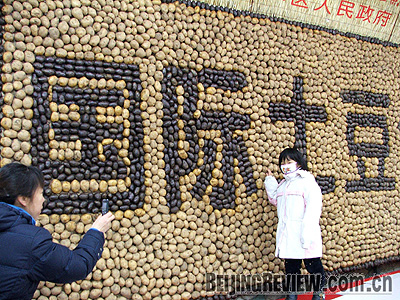|

POTATOES RULE: 2008 is the "International Year of Potato" and China seeks to reform its potato industry to ease the dependency on imported processed potato products
When asked how they eat potatoes, probably most Chinese, especially the elderly, would answer: stir-fried potato threads. A few children, more likely students, would remark: potato chips.
In KFC or McDonald's, a tiny bag of French fries, coupled with a packet of ketchup, costs about 7 yuan ($1). Any time they come to KFC or McDonald's, people are apt to purchase a bag of French fries.
A bag of potato chips can be sold at 10 times the cost of producing it.
What worries some is that French fries that Chinese children prefer are mostly foreign brands, such as those from Lay's and Pringles, McDonald's and KFC.
China tops the world in terms of planting area of potatoes, which numbers more than 5 million hectares. It is currently also the world's largest potato producer, with an annual output of over 70 million tons.
But it's impossible for Chinese farmers to make a fortune on potatoes because the country's processing industry lags far behind the rest of the world.
Nowadays in China, foreign fast food stores like KFC can rake in several hundred million yuan from sales of potato products like mashed potatoes and French fries. Compared with their foreign peers, China's 5 million hectares of potatoes seem like a waste.
The year 2008 is the "International Year of Potato," and fortunately the Chinese Government has pledged stiff efforts on the potato industry.
A market to explore
Generally, potatoes are used in three ways: eaten as vegetables, as processed food like potato chips or used as processed non-food products like starch. Data from the Information Center under the Ministry of Agriculture showed that 90 percent of China's potatoes are eaten as vegetables, and a minimum 4 percent are intensively processed.
Beside chips, potatoes can also be converted into fine starch and modified starch, which are widely used in various industries. Furthermore, China's demand for these products is rising. According to the Information Center under the Ministry of Agriculture, China now produces only around 300,000 tons of modified starch annually, far from enough to meet domestic demand of 800,000 tons.
According to Wang Wei, Chairman with the Specialized Committee of Potato under China Food Industry Association, China has also become one of the most potato-consuming countries, with its potato consumption growing 40 percent in the past five years. The swelling market demand has left a huge deficit of downstream potato products.
What has curtailed the intensive potato-processing industry? A report by the Ministry of Agriculture blamed it on the following aspects:
The first problem is the outdated equipment for intensive processing and the handicapped capabilities to develop new products. Most of Chinese potato processors are small, and process products with little technological content. There are currently only around 20 potato starch plants recognized by national standards in China. Due to a weak productivity, they are hardly able to satisfy the market demand and have to rely on imports.
The second is insufficient potato varieties suitable for processing. Up to date, China has fostered more than 20 potato varieties, but has an unbalanced structure. Most of them are high-yield, early-maturing, high-starch and suitable for frying, but have disadvantages in scale.
The third is unqualified technologies. What currently prevails in China is still the traditional storage in cellars, where the potatoes may easily rot or germinate. As a result, their quality and value is reduced, and it is hard to scale up. The report by the Ministry of Agriculture also pointed out that the problem of potato storage technologies looms large in China, hindering the development of the industry.
In action
Wei Chao'an, Vice Minister of Agriculture told Oriental Outlook that future development of the potato industry will be aligned in tune with the market demand, and braced up by scientific technologies. Leading processing enterprises will be bred to engineer the development of new varieties and research and promotion of new technologies. Efforts will also be made to upgrade capabilities for potato production, processing, storage and circulation.
According to Wei, the Chinese Govern-ment will push forward the standardization and industrialization of potato planting, added Wei.
"The potato enterprises will be backed to jointly set up production bases, and share profits, as well as risks with the planters," said Wei.
Special heed will be paid to international cooperation on potato planting and processing, especially on prevention and control of crop diseases, high-yield cultivation, as well as introduction of advanced equipment.
The planting, processing and sales of potatoes have always enjoyed support from the Central Government, and are even priorities for some governments of potato-planting areas. Every year, many trade fairs are held to spur the development of the industry.
Qu Dongyu, Director of the China Potato Specialty Council, said what matters most is to set up several leading enterprises, develop technologies of scale planting and storage, and extend the sales network and industrial chain.
"China is pampered with unparalleled natural conditions for the potato industry. But it still needs concerted effort to translate the natural advantages into profits," said Qu. | 